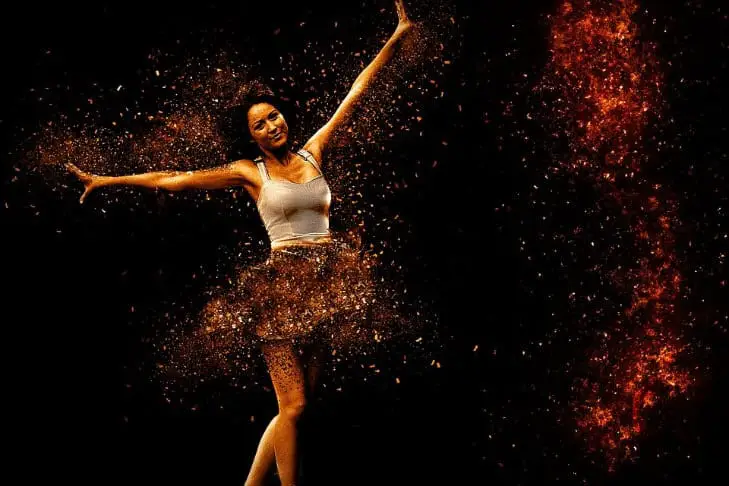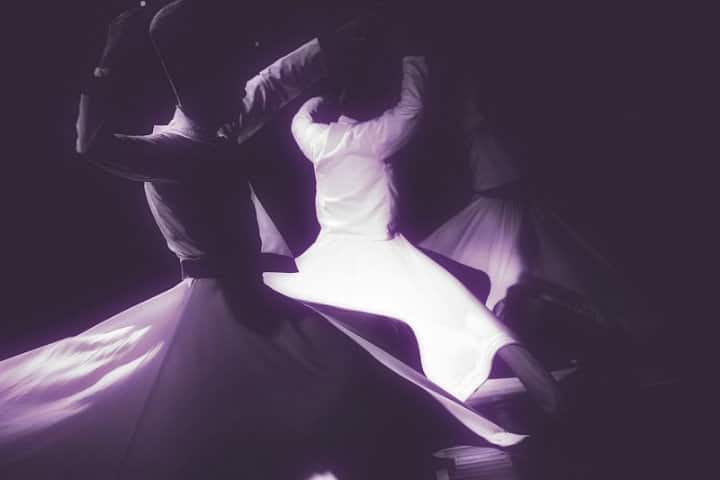
I’ve always been fascinated by the art of dance, and overall, the movement of the human body. It has been proven that the way you move, has a direct effect on the way you feel.
That’s why, if you want to feel energized, you just act on your part and achieve the desired state within seconds or minutes. Keep your chin up, walk faster, straighten your back, explore the city through jogging and you feel like conquering the world in no time. On the other hand, slouch your way through the day, and you’ll get what you ask for.
How movement and spirituality are interrelated:
Many physical activities can take you to the higher realms of consciousness. Dance has been used for millennia to induce trance-like states. There’s the Native American Ghost Dance, the Classical Indian Dance, The Whirling Dervishes of the Mevlevi Order, The Fire Walking Dance, The Cobra Gypsies of Rajasthan, and the Eleusinian Mysteries or Bacchanalia of antiquity (just to name a few). These dances mainly take place in the presence of other members of the community. The moves are highly repetitive and enable participants to separate themselves from their egos and move to another state of consciousness.
1. My own experience with spiritual dance
I once tried to dance to Classical North Indian Music with a very high tempo, and it brought me a feeling of ecstasy. I think that I could compare it to what in psychology, we call the state of flow. The time becomes irrelevant, you reach a very high level of performance, your brain is flooded with feel-good hormones, and most importantly, you’re not inhibited by your ego which tells you that you can’t do it, or makes you feel apprehensive of what other people might think. That’s the state of effortless mastery musicians experience after years of practice.

2. Altering your state by pushing to the edge
The same kind of state might be reached by exerting yourself and pushing to the limit of one’s physical ability. During my Ju-Jitsu days, I once saw a documentary about Karate masters. They were saying that at the very moment when they couldn’t continue the strenuous exercise, they were able to reach an altered state of mind. Instead of intense pain, they felt great pleasure which enabled them to continue the practice. The same thing comes from top athletes who push beyond the limit, reach an ecstatic state, and then, feel they’re able to accomplish anything. This is when many of your sub-minds temporarily unify on a single activity.
3. The modern approach to spiritual dance
There are also modern dance traditions that have nothing to do with religion but are conducive to ecstasy. A prime example of that is The Rave. To a cultured person, a Rave party might look like a return to barbarism, but it is a grand soul ceremony not too different from the Greek Dionysian Mysteries or Roman Bacchanalia. There’s a great gathering of people, there are psychedelic drugs (especially MDMA – Ecstasy), there’s repetitive, loud music, and dance, dance until the early morning. It usually takes place in some underground place. Everyone is dripping with sweat, drunk on pheromones, and filled with entheogens. The music is an effective hearing-loss device. The lasers and lights are blinding. But you don’t care, and you rave on until the sun comes up, or you have to be taken to the hospital with heart palpitations.
4. Spiritual Dance in North India
The modern approach to movement and spirituality isn’t always about an obscure club or a squat. It might be situated in the mountains of India. Villages like Kasol or Tosh in the state of Himachal Pradesh are famous for their rave parties, which regularly take place in remote forests of the region. People gather in circles and smoke hashish from a traditional pipe called chillum. I’ve been to these villages and they are a magnet for psychedelic explorers from all around the world (PSST, don’t tell anyone). Rave party hardly looks like a spiritual act, but when experienced properly, it is a ritual that enables participants to come back to their roots (or at least removes social inhibitions and the formality of everyday life). Archaic revival baby.

5. The Artful Movements of Yoga
Every day, millions of people around the world practice yoga. In the West, yoga is treated mainly as a physical exercise that offers many potential health benefits. The tradition was born as far as 3500 BC in India, but only in the XX century, it was brought to Europe and the USA. Since then it has been packaged and disseminated around the globe. Rishikesh, “The birthplace of Yoga” was still calm and serene when The Beatles went there to learn sitar, smoke weed, and develop songs for The White Album. Today, it has become a place for Westerners who pay inordinate amounts of money for yoga and meditation retreats. But the roots of yoga are still alive in many places where it’s treated as a true meditative practice. In many temples especially in India and China, it consists of meditation, breathing exercises, a range of different body postures, and dynamic movements that help yogis to balance their Chi or wind energies.
6. Spreading movement around the world
There has to be something in this practice because it was adopted in various forms by Muslims, Christians, as well as Sikhs. The first person to introduce Yoga to Islam was Al Biruni, the famous Persian scholar of the Islamic Golden Age who stayed in India for many years to translate some of its sacred texts into Farsi and Arabic. The Yoga practice was adopted mainly by minority sects, to the disapproval of Sunnis and Shia. With the modern resurgence of reactionary Islam, Mullahs of the world started hurling fatwas at it and calling it haram.
7. The walking meditation
If you’re not a fan of putting your body in uncomfortable positions for protracted periods, you may try the Walking Meditation. It’s very simple but can lead to profound insights. I first learned about it while reading Mindfulness in Plain English, a book that I highly recommend to anyone with a skeptical mind who wants to learn more about meditation and peace of mind. There’s also an interesting chapter on this topic in the classic secular spirituality genre, Jon Kabat-Zinn’s Wherever you go, there you are. Lolling around for hours on end is smirked upon in our culture. During our busy lives, we always have to get somewhere fast. There’s a constant pressure to make every minute count and produce something of value. When was the last time you just went for a walk without any purpose in mind? That’s the core of the walking meditation. Just go outside, walk slowly, take small steps, put a small creepy smile on your face, and concentrate on breathing. Don’t look at the watch, and don’t listen to music, or the newest podcast. Try to just observe what’s going on in your neighborhood (or better yet, a new place). You will see a thousand new details that you’ve missed before. You will find that you’re outside of the chase, and start to wonder where all these people on the street are going. Then you’ll realize that during most of the waking hours, you behave just like them – running after something. Maybe you’ll see a group of small children and instead of passing them by, you’ll appreciate their youthful energy. There might be a small dog sitting on the lap of an elderly woman. You’ll notice the scene and you’ll be moved almost to tears. I’m not joking. Try it for yourself.
8. Be like the Zen monk in Baraka
In the visually mesmerizing film “Baraka,” a contemplative scene captures the serene aura of a Zen monastery. An ascetic monk, swathed in the traditional saffron robe, sits in silence, embodying the essence of meditative practice. Surrounded by the monastery’s ancient walls, the camera frames him against a backdrop of flickering candles and shadowy alcoves. As he remains steadfast in his spiritual journey, the monk’s unwavering focus and tranquility create a poignant sense of connection with the universe.
9. Tantric love – pleasure, art, and movement
If you have any more doubts about the connection between movement and the state of ecstasy, you haven’t tried tantric sex. Tantra, now associated mainly with sex is, in fact, an ancient Hindu tradition that contained many spiritual practices. In some of the minority sects, however, there was an element of sex that was supposed to lead practitioners into higher spiritual planes. Then, this idea was swiftly captured by the West. As Geoffrey Samuel, a Professor in the School of Religious and Theological Studies at Cardiff University writes: ‘Tantra’ as a modern Western sexual and spiritual practice, however complex and contested its origins in Asia, was and is more than a fringe phenomenon of the 1960s and 1970s counterculture. On the contrary, it took up themes of considerable depth and significance within Western culture and synthesized them creatively with borrowings from Buddhist and Hindu sources. Its slow but steady growth since the 1970s suggests that its potential has not yet been exhausted.”
10. The modern approach to movement and spirituality
Of course, during the ’60s and ’70s especially in California, there were lots of gurus (Osho being the most infamous example), who sexually exploited many women in the name of spirituality. Now, when you google tantric sex, you get Cosmopolitan Magazine which teaches you four tantric sex positions and urges you to grab some pizza, drink some wine, watch a movie, and then grab your partner and fuck them in a spiritual manner. But if you search a bit more, and approach it with dignity, tantric sex can be a deeply rewarding experience. How did you like this article about the movement of the human body and its connection to spirituality? Next up, you may want to explore a guide to the most notable spiritual disciplines and the top spiritual book publishers.
Hey there, welcome to my blog! I'm a full-time entrepreneur building two companies, a digital marketer, and a content creator with 10+ years of experience. I started RafalReyzer.com to provide you with great tools and strategies you can use to become a proficient digital marketer and achieve freedom through online creativity. My site is a one-stop shop for digital marketers, and content enthusiasts who want to be independent, earn more money, and create beautiful things. Explore my journey here, and don't forget to get in touch if you need help with digital marketing.

